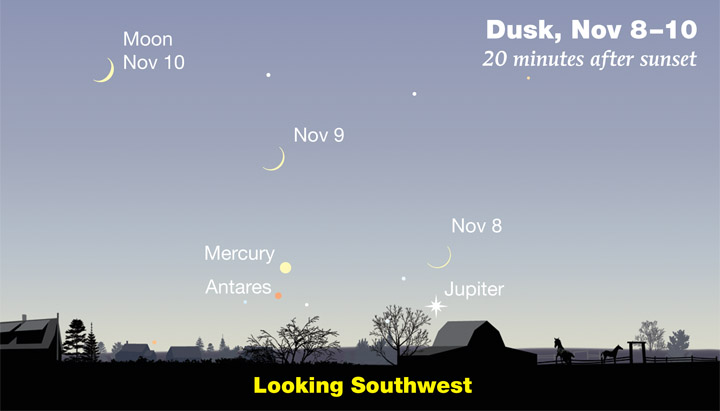
Friday, November 9
• As twilight fades, the crescent Moon in the southwest directs you down to Mercury and fainter Antares, as shown above. Too early the sky will still be too bright; look too late and they'll be too low or setting! Your best chance will probably be 20 to 30 minutes after sunset. Bring binoculars.
• Algol should be at its minimum brightness, magnitude 3.4 instead of its usual 2.1, for a couple hours centered on 11:21 p.m. EST (8:21 p.m. PST).
• Happy 84th birthday, Carl Sagan (November 9, 1934 – December 20, 1996). If only.
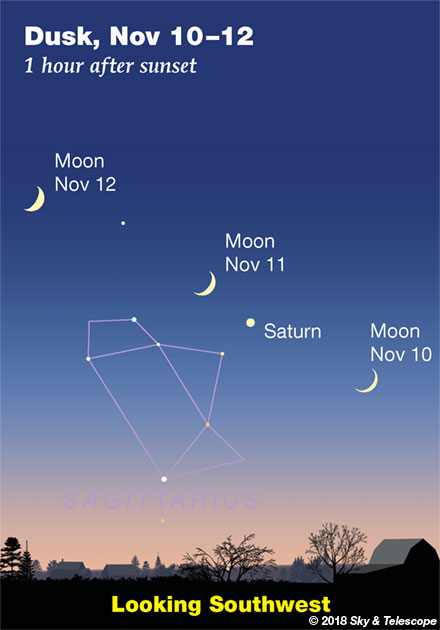
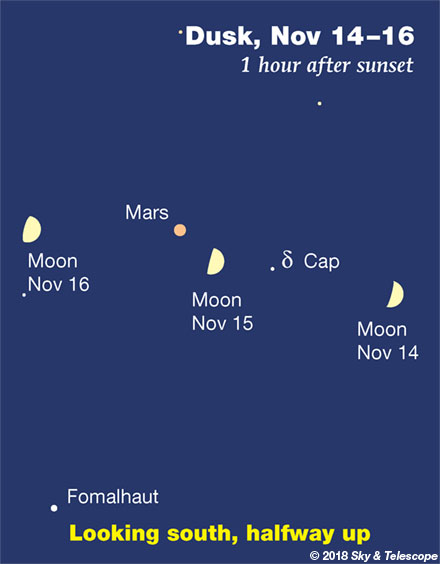
Saturday, November 10
• The "star" glowing upper left of the crescent Moon during and just after dusk is Saturn, as shown here. It's currently 4,075 times more distant than the Moon.
Sunday, November 11
• These evenings Capella is the brightest star in the northeast, climbing the sky as winter approaches. It's the equal of Vega, which is descending in the northwest as summer fades into the past.
Look for the Pleiades to Capella's right by three fists at arm's length. As evening grows later, orange Aldebaran climbs up below the Pleiades. By about 8:30 (depending on your location), Orion is clearing the horizon below Aldebaran.
Monday, November 12
• Vega is the brightest star in the west in early evening. Its little constellation Lyra extends to its left. Somewhat farther left, about a fist and a half at arm's length from Vega, is 3rd-magnitude Albireo, the beak of Cygnus the Swan. Albireo is one of the finest and most colorful double stars for small telescopes.
• Algol should be at its minimum brightness for a couple hours centered on 8:10 p.m. EST. If you glance up at Algol at any random time, you have only a 1 in 30 chance of catching it at least a magnitude fainter than normal.
Tuesday, November 13
• As dawn begins to brighten Wednesday and Thursday mornings, spot Venus low in the southeast. First-magnitude Spica, about 1/200 as bright, will be only 1¼° above Venus or to its upper right.
Wednesday, November 14
• The Moon shines in Capricornus this evening. The bright orange point to its upper left is Mars. Several times farther to the Moon's upper right shines Altair, accompanied by little Tarazed (Gamma Aquilae) a finger-width to Altair's upper right.
Thursday, November 15
• First-quarter Moon (exact at 9:54 a.m. EST today). It's close to Mars this evening, as shown above.
• The Moon is nearly at apogee; does it really look a trace smaller than usual? And spot Fomalhaut about 20° to the Moon's lower left.
Friday, November 16
• From very high in the south this evening, the right side of the Great Square of Pegasus points down toward the Moon.
Saturday, November 17
• When the waxing gibbous Moon passes highest in the south in early evening, it'll be straight below the Great Square of Pegasus, which is now level and upright.
• The Leonid meteor shower, which has been very weak this decade, should be at its modest best in the three hours between moonset and the beginning of Sunday's dawn.
________________________
Want to become a better astronomer? Learn your way around the constellations! They're the key to locating everything fainter and deeper to hunt with binoculars or a telescope.
This is an outdoor nature hobby. For an easy-to-use constellation guide covering the whole evening sky, use the big monthly map in the center of each issue of Sky & Telescope, the essential guide to astronomy.

Once you get a telescope, to put it to good use you'll need a detailed, large-scale sky atlas (set of charts). The basic standard is the Pocket Sky Atlas (in either the original or Jumbo Edition), which shows stars to magnitude 7.6.
Next up is the larger and deeper Sky Atlas 2000.0, plotting stars to magnitude 8.5; nearly three times as many. The next up, once you know your way around, are the even larger Interstellarum atlas (stars to magnitude 9.5) and Uranometria 2000.0 (stars to magnitude 9.75). And read how to use sky charts with a telescope.
You'll also want a good deep-sky guidebook, such as Sue French's Deep-Sky Wonders collection (which includes its own charts), Sky Atlas 2000.0 Companion by Strong and Sinnott, or the bigger Night Sky Observer's Guide by Kepple and Sanner.
Can a computerized telescope replace charts? Not for beginners, I don't think, and not on mounts and tripods that are less than top-quality mechanically (meaning heavy and expensive). And as Terence Dickinson and Alan Dyer say in their Backyard Astronomer's Guide, "A full appreciation of the universe cannot come without developing the skills to find things in the sky and understanding how the sky works. This knowledge comes only by spending time under the stars with star maps in hand."
This Week's Planet Roundup
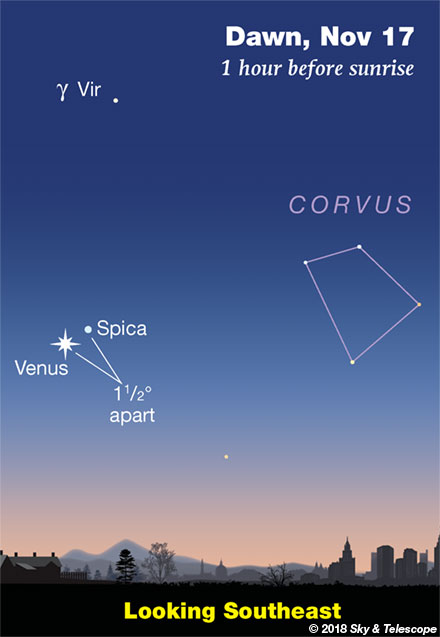
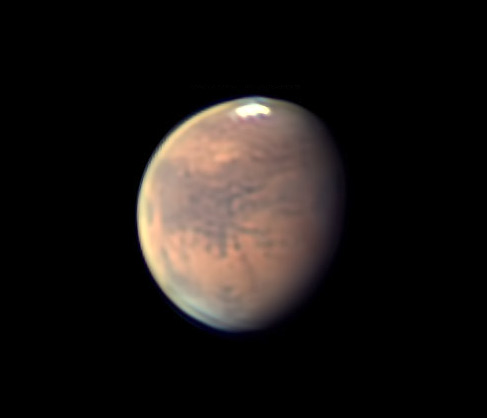
Mercury (magnitude –0.2) is just above the southwest horizon in bright twilight. This is the best week of its poor October-November apparition. Your best chance to spot it is about 20 or 30 minutes after sunset. Bring binoculars. Can you still catch Jupiter increasingly far to Mercury's right or lower right?
Venus (magnitude –4.6) is rapidly ascending in early dawn day by day. Look for it shining as the "Morning Star" in the east-southeast, as shown here. A little more than 1° from it all week is Spica, only about half a percent as bright.
In a telescope Venus is a dramatically thin crescent, thickening from 7% to 12% sunlit this week. For sharper telescopic views, follow it up higher past sunrise and into the blue-sky day.
Mars (fading from magnitude –0.4 to –0.3 this week) shines highest in the south around the end of twilight. It set around midnight.
In a telescope Mars is 11 arcseconds wide, and it's still as gibbous as we ever see it: 86 percent sunlit. For a Mars map that displays which side is facing Earth at your time and date, use our Mars Profiler.
Jupiter (magnitude –1.7) is disappearing far down into the bright sunset; see Mercury above.
Saturn (magnitude +0.6, in Sagittarius) is getting low in the southwest in late twilight, some 50° to the lower right of brighter Mars.
Uranus, near the Aries-Pisces border, is pretty easy to see in binoculars at magnitude 5.7 — with a good finder chart, if you know the constellations well enough to see where to start with the chart.
Neptune, in Aquarius, is harder at magnitude 7.9. They're well up in the southeastern side of the sky after dark. Finder charts for Uranus and Neptune, or see the September Sky & Telescope, page 48.
______________________
All descriptions that relate to your horizon — including the words up, down, right, and left — are written for the world's mid-northern latitudes. Descriptions that also depend on longitude (mainly Moon positions) are for North America.
Eastern Standard Time (EST) is Universal Time (UT or GMT) minus 5 hours.
______________________
"The dangers of not thinking clearly are much greater now than ever before. It's not that there's something new in our way of thinking, it's that credulous and confused thinking can be much more lethal in ways it was never before."
— Carl Sagan, 1996
______________________
"Objective reality exists. Facts are often determinable. Vaccines save lives. Carbon dioxide warms the globe. Bacteria evolve to thwart antibiotics, because evolution. Science and reason are not a liberal conspiracy. They are how we determine facts. Civilization's survival depends on our ability, and willingness, to do this."
— Alan MacRobert, your Sky at a Glance editor
______________________
"Facts are stubborn things."
— John Adams, 1770
 1
1








Comments
Rod
November 11, 2018 at 7:23 pm
Did any view the waxing crescent Moon, Saturn, and Mars on the 10th and tonight?
The waxing crescent Moon and Saturn were quite lovely tonight and last night as well along with Mars. I viewed near 1800 EST using unaided eyes, 10x50 binoculars, and my 90-mm refractor from 31x to 200x range. Excellent late fall weather here in Maryland, clear skies and colder temps down near 0C. The waxing crescent Moon had earthshine and at 31x and 40x views, quite enjoyable. Very cool views of the terminator line with craters using my telescope. Last night and tonight was excellent along the ecliptic.
You must be logged in to post a comment.
You must be logged in to post a comment.